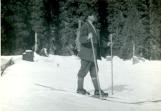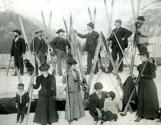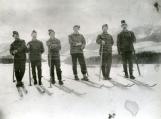1
Norwegian immigrants are credited with bringing skiing to Revelstoke. For Norwegians, skiing was simply something that "everyone did." Skis were homemade and rudimentary but practical. The earliest mention of skis in the Revelstoke area was in the 1890 Revelstoke newspaper telling of Norwegian immigrant, Ole Sandberg, skiing from his mining claim in Albert Canyon to the train station. Ole's skis were made from barrel staves. People marveled at these "Norwegian Snowshoes" also known as "slicks." It didn't take long for people to become convinced that not only was this practical equipment for the winter, but fun too.2
Ole Westerberg carrying the mail up the Big Bendc 1900 (?)
Big Bend, North of Revelstoke, British Columbia
 Credits:
Credits:Revelstoke Museum and Archives
3
Local merchant, F.B. Wells, imported skis from Minnesota to sell in his store. They were 10 feet long with beautiful scroll work along the top. In 1891 and '92, people were traveling long distances on these Norwegian Snowshoes. The newspaper of 1891 reports of 5 "old timers" skiing to Revelstoke from Arrow Lakes (a distance of 28 miles) on the "new footwear; and in January 1892, the Kootenay Star reports of 4 men skiing from Lardeau City to Revelstoke (40 miles) on Norwegian Snowshoes. This could well have been the first long distance ski trip in Canada. In 1891, an informal ski club had started in Revelstoke and a tradition and way of life on skis was launched for the community.5
There were two families that were instrumental in bringing the skiing tradition to Revelstoke: the Gunnarsens and Nelsens.Jorgen and Anna Gunnarsen came to Revelstoke in 1923 with their 3 sons (a 4th was born in Canada). Jorgen was an avid cross country racer and a cabinet maker, making skis for youngsters in town. Anna became the matriarch of skiing in Revelstoke, winning many local races as well as races in Banff and Calgary. Anna would be handicapped as much as an entire city block simply to get other contestants to enter the race. In one race she started behind the 17 year old boys and still succeeded in passing them! Anna raced until the age of 48 and was instrumental in promoting the sport of skiing in Revelstoke.
Anna and Jorgen's 4 boys all were skiers and competitors, whether in cross country, jumping or slalom. Hans and Gunnar were the strongest jumpers and racers. Carl and Emil were also jumpers and Carl later became a Hill Captain for the Nels Nelsen jump.
7
The other family instrumental in bringing skiing to Revelstoke was the Nelsen family. Also from Norway, the Nelsens knew the Gunnarsens and arrived in Revelstoke the same year, 1913. The two families were instrumental in getting the Revelstoke Ski Club officially formed in 1914 and the first Winter Carnival Tournament was held in February 1915.The two Nelsen boys, Nels and Ivind, became excellent jumpers. Nels held the Canadian record for ski jumping from 1916 to 1932. He jumped to a World Record in 1925 which remained unbroken for 5 years.
8
Nels Nelsen, Revelstoke's ski jumping champion1925
Revelstoke, British Columbia
 Credits:
Credits:Revelstoke Museum and Archives
9
Ivind Nilsen, Nels' younger brother, was known for his perfect form. He was often compared to a bird in flight. Ivind's last name is spelled as it was in Norway. Nels changed the spelling of his last name to be more anglicized. Ivind also set World Records in the Boys' Division.10
Ivind Nilsen ski jumpingc. 1920 (?)
Revelstoke, British Columbia
 Credits:
Credits:Revelstoke Museum and Archives
11
Paul Salva on first ski clubs and jumping in Revelstokeearly 20th century
Revelstoke, British Columbia
 Credits:
Credits:Paul Salva
12
The townspeople of Revelstoke were thrilled with the idea of skiing and quickly took to its various forms. There were plenty of competent wood workers who could make their own skis for their family and friends. Most skis in town were handmade birch. Carl Gunnarsen recalled cutting the birch, splitting and drying the wood and his father making skis. Once the jumpers graduated to the "D" Class jump they were mostly using hickory skis. Jumps were built all over town and "ski running" was practiced throughout the winter. Not only was it fun but it was a practical way to negotiate the massive amounts of snow that could fall in Revelstoke. Ski-joring became another winter amusement, combining the strength of a horse with the sliding capabilities of the skis. Ski-joring events were held at Winter Carnivals but it was also done for fun down the main street, Mackenzie Avenue.13
Ski-joring, Mackenzie Avenuec. 1911
Revelstoke, British Columbia
 Credits:
Credits:Revelstoke Museum and Archives
14
Albert Canyon Ski Clubc. 1899
Albert Canyon, east of Revelstoke, British Columbia
 Credits:
Credits:Revelstoke Museum and Archives

